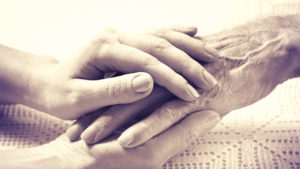 At first, I couldn’t make out what the person on the other end on the line was trying to say. Between her sobs, I told my caller to take a deep breath and try again to tell me what was wrong. The caller was Sally, the daughter of one of my homecare/hospice patients. Sally started again and explained that her mom had passed away while in the shower, and she needed someone to help.
At first, I couldn’t make out what the person on the other end on the line was trying to say. Between her sobs, I told my caller to take a deep breath and try again to tell me what was wrong. The caller was Sally, the daughter of one of my homecare/hospice patients. Sally started again and explained that her mom had passed away while in the shower, and she needed someone to help.
I happened to be at the end of my patient schedule for the day and not too far from my patient’s apartment. I made a quick u-turn and was knocking on her door within ten minutes. Sally answered immediately and drew me into the apartment explaining her mom would be mortified for anyone to see her in this condition. Sally had dried her mom and covered her, but without some assistance, could not get her onto the bed or dressed.
Once I arrived, I assessed her mom, and then made the appropriate phone calls. Together Sally and I moved her mom onto the bed, where Sally dressed her in a gown and combed her hair. I sat with her until her brother arrived, followed by the nurse and the funeral home.
Sally called me about a year later to say how much it meant that I came when she needed help. She said my name was the first she thought of, because I had always been so easy to communicate with and available for her questions. Her call helped remind me of that there is an invisible group that stands behind each patient. In Sally’s case, there was just one person helping, while other patients have several family members or aides assisting with care. While caregivers aren’t our patients, they are profoundly impacted by our practice and should be considered whenever possible. Here are a couple of suggestions to stay connected with your patient’s caregivers.
Try to schedule visits when the caregiver is available. Many times caregivers are not able to attend therapy sessions, but if possible, include them in your visit at least early in the therapy schedule and then as you hit milestones. Depending on your company’s policy and patient preferences, you could also establish communication with the caregivers via email or phone.
Leave printed materials and handouts to reinforce your visit. Informative patient education and exercise handouts increase compliance and thus progress. Always leave clear professional materials to help patients and caregivers continue to work between sessions. (This need was part of the inspiration behind the creation of my book The Occupational Therapy Toolkit!)
Establish a written log to facilitate communication with caregivers. Many families start a written log posted in a central location. The therapeutic team can add highlights of their visit including any changes in the therapy routine. Caregivers can also use the log to start conversations with the team and patient about care, recommendations or modifications. Just be sure to follow your company’s policy, have the patient give permission for information to be shared with the caregivers, and suggest the log be stored in a location where others can’t read it.
